Last updated on July 7th, 2019
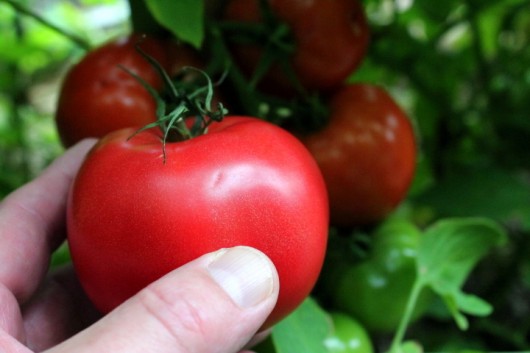 Wanna get the biggest bang from your tomato-growing buck? You’ve come to the right place! Here is everything I’ve learned over the years about planting and growing Solanum lycopersicum:
Wanna get the biggest bang from your tomato-growing buck? You’ve come to the right place! Here is everything I’ve learned over the years about planting and growing Solanum lycopersicum:
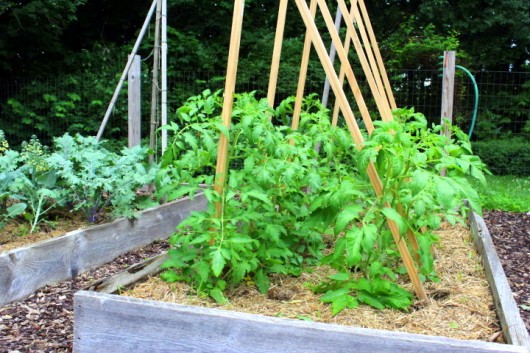 First, select the right tomatoes for your needs. Tomatoes come in both determinate and indeterminate varieties. Determinate types produce all of their fruit around the same time, on mounded, 18 – 24-inch-tall plants. Indeterminate types are defined by exuberant vines that grow (and grow!) until frost. On these, blossoms and fruit emerge continuously throughout the warm weather season. If you want lots of tomatoes over a long period — I certainly do — then indeterminates are your friend.
First, select the right tomatoes for your needs. Tomatoes come in both determinate and indeterminate varieties. Determinate types produce all of their fruit around the same time, on mounded, 18 – 24-inch-tall plants. Indeterminate types are defined by exuberant vines that grow (and grow!) until frost. On these, blossoms and fruit emerge continuously throughout the warm weather season. If you want lots of tomatoes over a long period — I certainly do — then indeterminates are your friend.
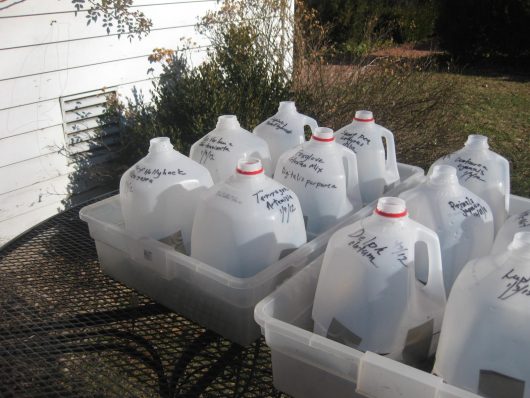 For the strongest plants, winter-sow the seeds outdoors. (Click here for details.) Winter-sown seedlings are stronger and sturdier than those born indoors on a windowsill or under lights. The seedlings do not require hardening-off.
For the strongest plants, winter-sow the seeds outdoors. (Click here for details.) Winter-sown seedlings are stronger and sturdier than those born indoors on a windowsill or under lights. The seedlings do not require hardening-off.
Confession: I don’t always grow my tomatoes from seeds. Some years I buy greenhouse-born seedlings from a local organic farm store.
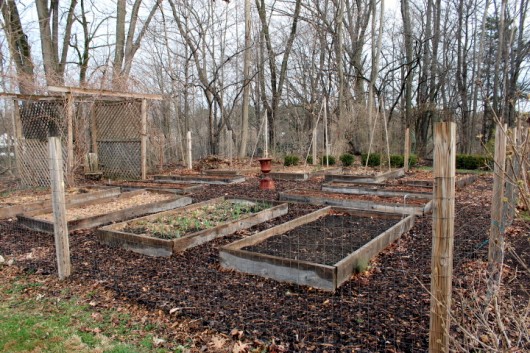 Give them high ground and full sun. A raised bed that receives all-day sunshine is ideal. If soil is infertile (i.e., worms are not evident when you dig into the soil), be sure to amend the bed with organic compost. Also, loosen the soil to a depth of 6-8 inches, and then work in some organic fertilizer that is suitable for tomatoes. I’ll address fertilizer in just a moment.
Give them high ground and full sun. A raised bed that receives all-day sunshine is ideal. If soil is infertile (i.e., worms are not evident when you dig into the soil), be sure to amend the bed with organic compost. Also, loosen the soil to a depth of 6-8 inches, and then work in some organic fertilizer that is suitable for tomatoes. I’ll address fertilizer in just a moment.
(Related post: How I Designed My Kitchen Garden.)
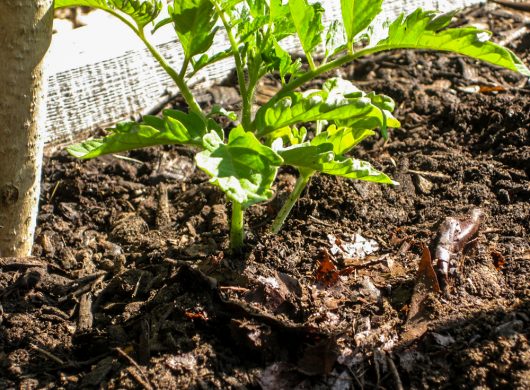 Plant deeply. Bury the seedling right up to its first set of leaves (or even deeper). New roots will emerge all along the covered stem, giving the plant the strongest possible start.
Plant deeply. Bury the seedling right up to its first set of leaves (or even deeper). New roots will emerge all along the covered stem, giving the plant the strongest possible start.
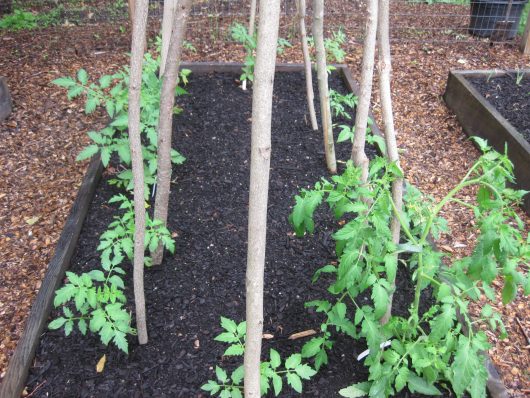 Allow Elbow Room. Set plants about 18 inches apart. Tomatoes need room to grow, and space for air to freely circulate.
Allow Elbow Room. Set plants about 18 inches apart. Tomatoes need room to grow, and space for air to freely circulate.
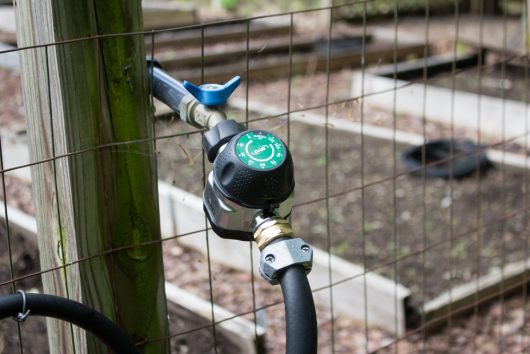 Provide reliable moisture. One-to-two inches of water per week is sufficient for tomatoes. A soaker hose on a timer (above) is ideal. Overhead sprinkling, unless it comes from Nature, is to be avoided. Wet foliage invites late blight, an insipid fungal disease. Uneven watering — such as thoroughly soaking the soil after it has dried out — will cause tomato skins to crack.
Provide reliable moisture. One-to-two inches of water per week is sufficient for tomatoes. A soaker hose on a timer (above) is ideal. Overhead sprinkling, unless it comes from Nature, is to be avoided. Wet foliage invites late blight, an insipid fungal disease. Uneven watering — such as thoroughly soaking the soil after it has dried out — will cause tomato skins to crack.
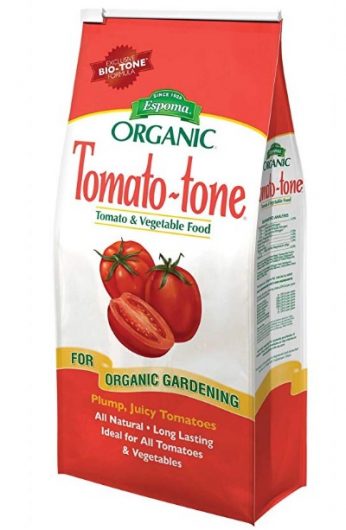 Feed for Flowers (not Foliage). Tomatoes enjoy food, but beware too much nitrogen. Nitrogen will only encourage lush foliage, not fruit-making flowers. I’ve tested lots of different fertilizers, and my current favorite is Espoma’s organic calcium-and microbe-rich “Tomato Tone” (click here for details). As mentioned earlier, you can — and should — work this granular food into the soil when you are preparing the bed.
Feed for Flowers (not Foliage). Tomatoes enjoy food, but beware too much nitrogen. Nitrogen will only encourage lush foliage, not fruit-making flowers. I’ve tested lots of different fertilizers, and my current favorite is Espoma’s organic calcium-and microbe-rich “Tomato Tone” (click here for details). As mentioned earlier, you can — and should — work this granular food into the soil when you are preparing the bed.
 Provide Support. This is especially important for indeterminate plants. Each spring, I give my tomatoes a wooden trellis that provides both height and stability. I use green velcro tape to tie vines loosely to the trellis.
Provide Support. This is especially important for indeterminate plants. Each spring, I give my tomatoes a wooden trellis that provides both height and stability. I use green velcro tape to tie vines loosely to the trellis.
Oh. Let me know if you’d like more information about the aforementioned wooden trellis. It is my pride and joy. Furthermore, the structure lends architectural drama to the garden.
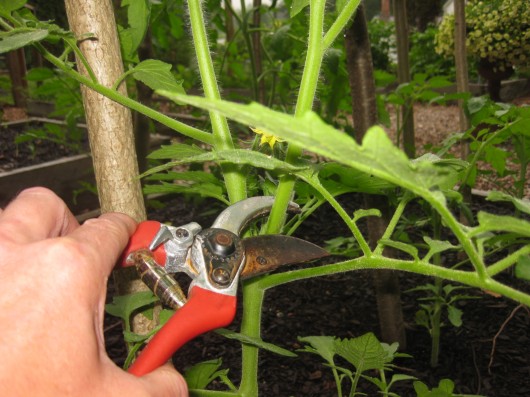 Sever the Suckers! To encourage a higher yield from indeterminate plants, pinch or cut off suckers. Suckers are energy-robbing offshoots that emerge between a tomato plant’s main stem and its leaf axils. If you want more tomato plants, simply stick the severed stems in soil, where will quickly grow their own set of roots. Click here to watch me de-sucker my tomatoes.
Sever the Suckers! To encourage a higher yield from indeterminate plants, pinch or cut off suckers. Suckers are energy-robbing offshoots that emerge between a tomato plant’s main stem and its leaf axils. If you want more tomato plants, simply stick the severed stems in soil, where will quickly grow their own set of roots. Click here to watch me de-sucker my tomatoes.
Remove all Volunteer Potatoes and Tomatoes. Potatoes, if forgotten in the garden after last year’s harvest, can quickly spread diseases to this year’s tomato-crop. Ditto for volunteer tomato seedlings that sprout in the compost pile or garden. Be safe, and remove these potential threats the moment they appear.
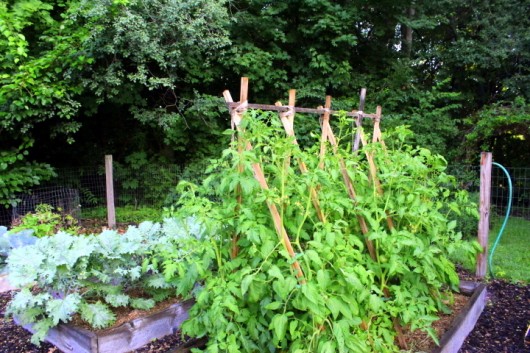 Mulch the plants. Mulch (weed-free straw for me), helps the soil to retain moisture. Furthermore, during a heavy rain, the mulch keeps water — and potential fungal spores – from bouncing off the soil and splashing onto the lower leaves.
Mulch the plants. Mulch (weed-free straw for me), helps the soil to retain moisture. Furthermore, during a heavy rain, the mulch keeps water — and potential fungal spores – from bouncing off the soil and splashing onto the lower leaves.
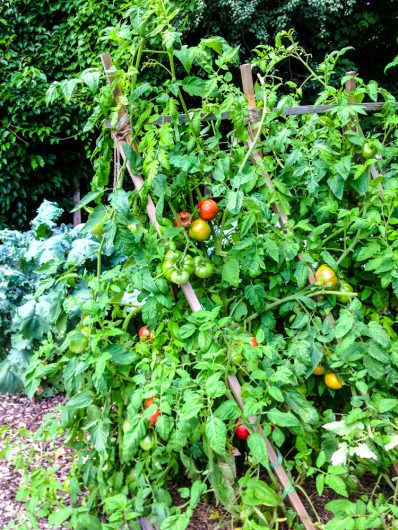 Alrighty then. I think you’ll find the above planting and growing program will make all the difference between a mediocre tomato harvest — and a mind-blowing one!
Alrighty then. I think you’ll find the above planting and growing program will make all the difference between a mediocre tomato harvest — and a mind-blowing one!
Got any tomato-growing advice you’d like to share? Speak your mind in the comments field below.
xGrandma Grandpa Kevin
Hungry for more? Get my email updates and subscribe to my YouTube channel.






Susan Hartwig says
Hi Kevin. I love your blog! I just wanted to add that you don’t want to sever suckers on determinate tomatoes, just the inderterminate. Also Copper fungicide sprayed every few weeks helps stave off blight. Wishing everyone a bountiful harvest this year!
Kevin Lee Jacobs says
Hi Susan – Great tips! Thank you.
Chris says
For indeterminate tomatoes, I have also found that , after the plants are about 3 feet tall, removing the first 12 inches of leaves from the ground up keeps rain from splashing up onto the leaves and contributing to both early blight and late blight. Long Island had quite a problem with both types of blight, especially with heirloom varieties ( because they have no anti-blight genes bred into them ) , decimating tomatoes by late July already , yet when I removed these 12 inches of leaves, my tomatoes were able to ward off blight until October, at which time it was time to pull up vines for the season anyway. Check with your county extension agent.
Sarah says
I used your trellis design last year with great success! An awesome way to provide stability from wind and make a good use of space. When the tomatoes topped my structure I just trained them along the top horizontally for even more space!
How do you keep weeds out of your paths between raised beds?
Kevin Lee Jacobs says
Hi Chris – Great idea, removing lower stems from indeterminates in order to keep rain from splashing up and reaching the plants. Thank you!
Hi Sarah – I’m glad the trellis worked out so well for you! As for weeds in paths…some I pull, some I fry with vinegar. Here’s the vinegar trick.
Michelle Collins says
Hi Kevin,
I always enjoy my Sunday morning read from you! Do you have a link for the trellis??
Thanks, Michelle-near Philly.
Victoria hesselbacher says
Hi Kevin,
Please send more info on your wooden trellis for indeterminate tomatoes.
Also, I’m embarrassed to ask: do you or do you not recommend pruning suckers from determinant tomatoes?
P.S. Your seedless straw mulch is fabulous on many levels.
Pauline Brocklehurst says
Loving the blog and tours round your great garden, not to mention yummy recipes!!
For a quick way to get seedlings, I now just find an organic tomato I like from the supermarket, lay a 1cm slice from the centre on compost in a pot, cover with more compost and in less than 2 weeks every single seed germinates and goes on to grow a great crop. Not always sure what sort they are but they taste just fine!
Kevin Lee Jacobs says
Hi Michelle – Tomato trellis how-to coming soon!
Hi Victoria – To get the most fruit from a determinate tomato plant, let the suckers grow. I’ll write a post about my trellis in a day or two. Please stay tuned!
Hi Pauline – Love your method for germinating tomato seeds!
Cynthia Greening says
I’d also like more info on your trellis!!! Your blog is fantastic and I share it widely. I’ve become a winter sowing devotee since I read your blog in 2012 … I winter sow about 500 heirloom tomatoes every year. I plant about 50 and then I give the remaining plants to the community. I’d love to get your trellis info!
Kevin Lee Jacobs says
Hi Cynthia – Thanks for reading and sharing my blog! Trellis post coming soon. I promise!
Janice says
When I moved to a new state several years ago, I joined the garden club and signed up to help grow tomatoes for the spring plant sale. The woman in charge (whom I privately christened the “tomato nazi” because of her habit of barking orders and generally unpleasant demeanor) insisted that, as you mentioned, to plant deeply…even laying the seedlings sideways if necessary but also to put a generous amount of crushed oyster shell in the planting hole. I had such success with her simple method that the oyster shell is all I use for fertilizer now. I volunteer elsewhere now though!
Judy says
Love growing tomatoes. Last year we moved to desert location. Squirrels everywhere, they ate my tomatoes, all of them. Any suggestions on how to deal with the little devils?
Louise says
Yes please link for how to make reellis as we will definitely do! And thank you for ALL your help… we down here in CT NEED IT … 2nd year with our
Raised garden!
Louise
Julie R says
Kevin, I really like the trellis idea for supporting tomato plants. And to Judy above who asked for suggestions on how to deal with squirrels, what I do is to sprinkle the soil around the plants with cayenne pepper or regular ground black pepper, once or twice per week and right after it rains. The squirrels don’t like it and it doesn’t harm the plants. Hope that helps.
Elizabeth Loeblich says
Thanks. for all the gardening help. I’m moving east and have never done winter sowing in jugs. Anxious to try. Do you sow the tomatoes in March with the tender annuals? Can’t wait to try your trellis! Look forward to the instructions.
bren english says
Hi Kevin, may I ask you to clarify something for me please-did you say to dispose of any and al tomato plant volunteers that may pop up from your compost pile due to fungal infections being passed on to your garden soil ? Also , would like to see plans for trellises please and thank you. All hail the mighty TOMATO… I am also a total devote to your winter sowing method and have been for years now. thanks for that!
Judy Hines says
Out here on the Central Illinois Prairie we use plastic milk jugs over tomato starts or else critters will wreck havoc.
After removing milk jugs — cages, the extra heavy kind found at most nurseries.
Tie sacks of moth balls wrapped in cheese cloth and hang from upper rims.
To keep horn worms away, tho a beautiful bug, sow basil seeds between plants.
Cathy Venegoni says
I love all the comments and suggestions, thanks Kevin …and friends :•)
My big QUESTION is: How to keep ground squirrels from nibbling on my
green/ripe tomatoes? I live in So California, and we have had exceptionally cool
weather this Spring and although I have tomatoes set already they aren’t ripening
due to the cold. Just this morning I went to check my crop and the critters are already
nibbling away. Last year I tried moth balls, coffee grounds and cayenne pepper. Nothing
worked. Any ideas or comments would be appreciated.
Laura says
Thank you Judy Hines for the suggestion of planting basil seeds in between tomato plants to ward off horn worms. I get them every year and personally I think they are disgusting especially if you get a lot of them and have to get them off the plants.
Lori says
Hi Kevin!
Because we have really bad blight in our soil, I grow my tomatoes in straw bales. All those other years, I’d get blight right away and would have to throw my first and only batch of tomatoes away and rip out plants. It was so frustrating.
I grow my tomatoes on a hog panel. Galvanized and 3 feet high, however they are hoisted on a fence post and wired bc the plants and tomatoes are heavy. For ties, I use old t shirts cut up into strips and stretched. I wrap in a figure 8 to protect the tomato stem from rubbing on the hog panel. I don’t tie them tight and it still holds.
And a fun little trick….use a vibrating toothbrush on the open flowers releases the pollen. I get tomatoes earlier if I do that. Just turn on the brush and hold the back of the brush on the back of the flowers. If they are ripe enough, you can watch puffs of pollen release. It’s magical.
Kevin Lee Jacobs says
Hi Lori – I love, love, love your electric toothbrush pollinating-trick!
Chris says
Hi Kevin! Last year my tomatoes were gorgeous outside but with a huge black area inside once I cut into them. Any ideas what this is and how to prevent it this year?
Jackie Willis says
Hi Kevin, I live in the southern part of Texas and this is my 2nd year of growing tomatoes in a raised bed. They are doing well ,my question is is it ever to late to prune back branches that are not bearing fruit? I have many flowers ( and I am going to try the toothbrush trick) and about 12 tomatoes so far. So can I cut back some of the foliage?
Kevin Lee Jacobs says
Hi Chris – What you described is internal blossom end rot. The culprit is usually uneven watering — i.e., letting the soil dry out and then saturating it. Click here for more details: UMass Extension Vegetable Program.
Hi Jackie – I would definitely prune suckers (click link in article above for more details), but I would hesitate to remove any other branches. Especially where you live — the southern part of Texas — fruit on a tomato vine can benefit from the shade that a well-branched plant will provide.
wonda Beck says
I have a problem with my tomatoes, they start curking leaves an turn a pale green then die. Have tried to transplant in pots but still died. It is going from one to another. Zone 9b and in ground. 4 out of 12 have died. What is wrong and what can I do? Have put cow manure around them, watered well and no effect. Had good tomatoes last year. Help please. Wondabeck@hotmail com
Kalanani Gallas says
A friend of mine swears by not watering tomatoes. She learned this while living in San Francisco where rain is infrequent. The tomato yield was very good, but what she noted most is the flavor was superior. Since then she continues not to water her plants, letting natural rainfall be enough. I also noticed while living inCalifornia that tomatoes growing out of the cracks in sidewalks produced abundant and tasty fruit. This year I plan to follow her lead, and incorporate all the excellent info here. Thanks, everyone, for dropping your knowledge.
Kevin Lee Jacobs says
Hi Wonda – Several factors can cause tomato leaf curl or “leaf roll.” Click here for more information courtesy of Texas A&M.
Lourdes says
I have 5 tomato plants ready to plant. Not sure if they are determinate or indeterminate. I cut a tomato that had seeds sprouting inside so I cut a 1/2 inch slice and planted it. I had to thin them out into other pots because most of the seeds sprouted.
They have grown very tall and spindly. Should I snip of the top of the plant so it gets bigger stems?
Kathy says
Kevin, do you think that putting crushed eggshells in the bottom of your planting holes would be just as good as the crushed oyster shells that someone else suggested? Thank you so very much for all your great recipes and advice!!
Joyce Platt says
Kevin, I always look forward to your Sunday morning posts. This week I am putting out my tomato plants and am intrigued by your trellis. Please give me more information on how to make them.
Thank you for your amazing recipes which I also make and enjoy.
Ellen Collins says
Hi, Kevin, and and thanks for all the practical information you always provide us. I had planned to ask for more info on the tomato trellis’ but see someone already has and you plan to give that info soon. Can’t wait to see how you do it. Now…on to my bread baking for the day.
Rhonda Strahler says
Hello Handsome! Granny (me) loves your videos! Should I sucker cherry tomato plants as well?
Cristy says
I too would be interested in your making of the trellis’s…
Thank you.
Loie says
Hi and Thanks for all the great info on landscaping, planting and cooking and baking-
I would love to hear more about the tomato trellises. I made your orange (strudel?) and we loved it. In these odd times, I decided to use cherries (I had ordered cherries from the grocery delivery man and got a can of cherry pie instead) so I used it as a filler for the dough and folded it over, and put the icing on top. it was very good.
Thanks for all your postings. You’re a bright, cheerful face in these uncertain times.
[email protected]
Loie
Suzanne Werner says
I’d love to see more info on how to build your trellis!
Franceen Elias-Stein says
My husband ‘built’ your trellis for me last year and it was fabulous! Can’t wait to get into my garden again!